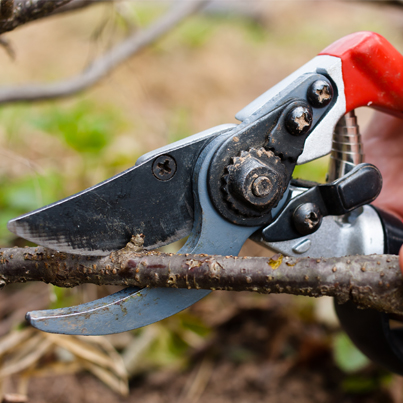Save the pruning for the spring
By Ryan McGeeney
U of A System Division of Agriculture
Nov. 17, 2017
Fast Facts:
- As trees go into dormancy, fresh pruning wounds may linger throughout winter
- While the amount of sap in trees remains constant throughout the year, its contents do change
(434 words)
(Download this story in MS Word format here.)

LITTLE ROCK – The leaves are off, and we know what you’re thinking: It’s time to take those branches down a notch, from the behemoth oak out back, to the delicate crape myrtles near the curb.
One word of advice: Don’t.
Put the pruners and saws back in the shed, and set a reminder for the early spring.
Caroll Guffey, Natural Resources Program Associate with the University of Arkansas System Division of Agriculture, said that although there has always been a cultural inclination to prune just as winter sets in, the practice actually goes against trees’ best interests.
“Pruning creates a wound,” Guffey said. “Trees aren’t actively growing this time of year — they’re trying to shut down for the wintertime. So that wound just lays out there, open, all winter.
“The potential for decay to establish is higher than if you’ll wait until February or March, when the trees are starting to first kick back in gear, and the roots are starting to grow,” he said. “At that time, they can start developing that callous that seals around a properly-made pruning cut.”
Les Walz, staff chair for the Cleveland County Cooperative Extension Service office in Rison, said he recently received a spate of inquiries as to the proper time to prune, and whether sap actuals “falls” inside trees, as “well-known fact” often leads us to believe.
“There seemed to be some pretty wide-spread misconception,” Walz said. “People were making management decisions based on ideas not necessarily rooted in logic.”
Working with Walz, Guffey later wrote an article for publication in the Rison area, outlining the physiological behavior and needs of trees entering dormancy.
“Trees actually maintain about the same amount of moisture all year long,” Guffey said. “About 50 percent of a live tree’s weight is water.”
But the chemical makeup of a tree’s sap does change throughout the year, Guffey said.
“During the active growing season, trees produce and use sugar to grow and maintain the leaves and produce the buds and flowers for next year’s leaves and seeds,” he wrote. “New wood — that growth ring exhibited by some trees species — is also produced.”
Guffey said understanding how trees change throughout the year can help landowners deal appropriately with issues that may arise, as well as anticipate recurring needs.
And when it is time to prune, Guffey said, don’t dress the wound with tar or any other substance.
“This actually seals in the potential rot-producing spores and makes it more likely it will develop rot,” he said.
To learn about seasonal tree care, contact your local Cooperative Extension Service agent or visit www.uaex.uada.edu.
About the Division of Agriculture
The University of Arkansas System Division of Agriculture’s mission is to strengthen agriculture, communities, and families by connecting trusted research to the adoption of best practices. Through the Agricultural Experiment Station and the Cooperative Extension Service, the Division of Agriculture conducts research and extension work within the nation’s historic land grant education system.
The Division of Agriculture is one of 20 entities within the University of Arkansas System. It has offices in all 75 counties in Arkansas and faculty on five system campuses.
Pursuant to 7 CFR § 15.3, the University of Arkansas System Division of Agriculture offers all its Extension and Research programs and services (including employment) without regard to race, color, sex, national origin, religion, age, disability, marital or veteran status, genetic information, sexual preference, pregnancy or any other legally protected status, and is an equal opportunity institution.
# # #
Media Contact: Mary Hightower
Dir. of Communication Services
U of A System Division of Agriculture
Cooperative Extension Service
(501) 671-2126
mhightower@uada.edu
Related Links